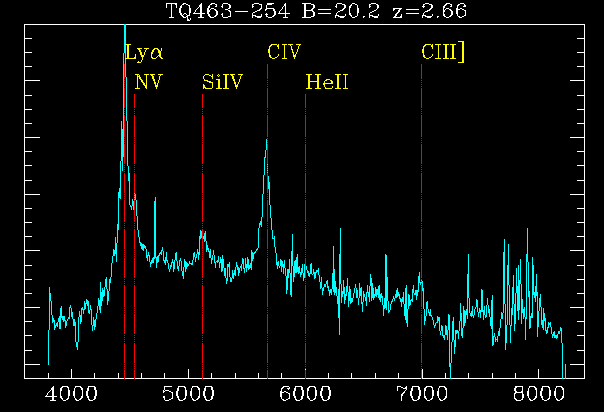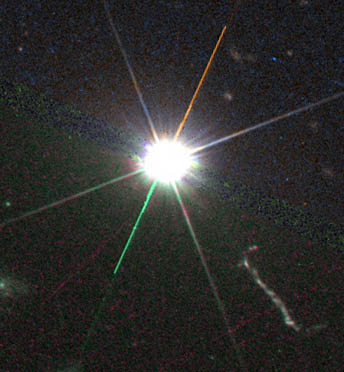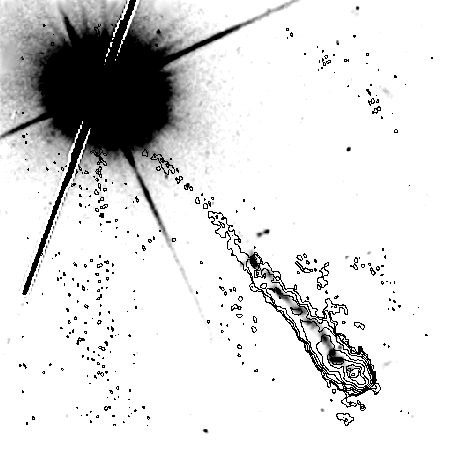Active Galactic Nuclei
Key points: What powers an active nucleus;
accretion and accretion disks; variability and its significance
As many as 10% of all galaxies produce too much energy
in their nuclei (centers) to be due to stars or starbursts. Some of these active galactic nuclei (AGN) make more energy than the entire Milky Way, but from a region no
bigger than the solar system! Categories of AGN include Seyfert galaxies, radio galaxies,
and quasars, also called QSOs (quasi-stellar objects). We suspect that all of this
activity is ultimately due to a very large black hole (mass of about 108 solar
masses).
| We have direct evidence for black holes in the
centers of other galaxies. For the galaxy to the right, the spectrum shows a line shifted
on the nucleus first far to the blue, then far to the red, due to a large range of Doppler
shifts from the huge mass. |
 |
 |
The behavior of the active nucleus can take different
forms, as we discuss below. However, the general pattern is illustrated in this imaginary
space ship journey through an active galaxy. (adapted by G. Rieke,
based on Mullard Space Science Laboratory animation) Here is a similar, slicker
version (reload to restart lecture animations) from Chandra, http://chandra.harvard.edu/resources/animations/blackholes.html
(reload to restart lecture animations) from Chandra, http://chandra.harvard.edu/resources/animations/blackholes.html |
Seyfert Galaxies --
Carl Seyfert first discovered a type of AGN. He noticed them because
they appeared to have stars superposed on their centers, which were really the bright glow
right around the black holes. The stellar appearing cores had emission lines implying very
hot sources were exciting them with strong ultraviolet light.
 |
We now know this ultraviolet output comes from the accretion disk. See how it lights
up a cone of glowing gas in the galaxy to the left. Only the cone of ultraviolet light can
escape from the cavity in the accretion disk where the black hole lies; in other
directions, the light is absorbed by the disk. (From STScI, modified by G. Rieke) The artist's concept below shows how the accretion disk
lets out just the cones of ultraviolet light.
(from APOD, V. Veckman,
http://antwrp.gsfc.nasa.gov/apod/ap040908.htm)
l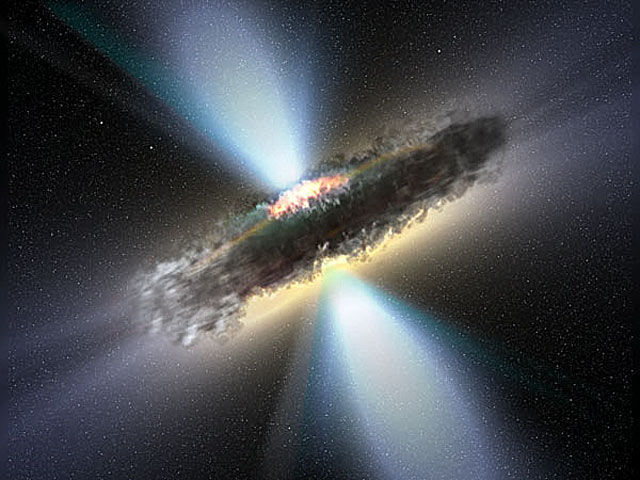 |
The spectra of their nuclei showed extremely strong and
broad emission lines; the broad lines imply that the gas producing them must be moving at
a large range of velocities.
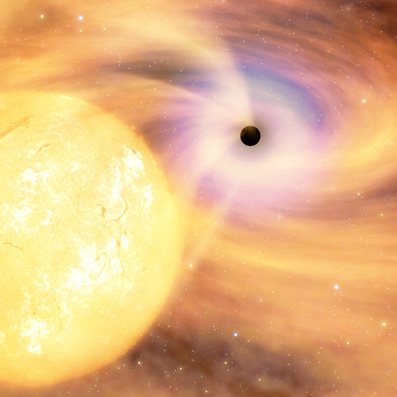 |
Although there isn't full agreement, one of the best ideas is that these lines come from stars that are too
close to the hot black hole and are having their outer layers stripped away and ionized to
create the bright lines, as in this artist's concept From IAC, http://www.iac.es/gabinete/noticias/2001/nov20.htm. The broad profiles are then due to the high
velocity of stars caught deep in the gravitational potential of the black hole. |
Luminosity of these galaxy centers alone can be 100
times that of the entire Milky Way. They are unusually bright in x-rays and infrared. Some
have rapidly varying light outputs, changing substantially in a week or a month.
Radio Galaxies
Both ellipticals and spirals can emit at radio wavelengths but the most powerful radio galaxies are ellipticals. They
fall into two broad categories:
1) galaxies with radio emission from the nucleus
only
2) galaxies with "lobes" or
"jets" which extend way beyond the visible galaxy in some cases:
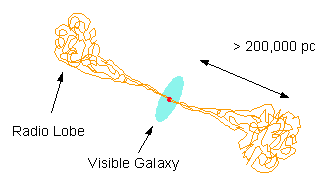
The visible (below with the HST instrument WFPC2) reveals little more than
extensive clouds of newly formed stars and dust, but in the near infrared (with NICMOS) we
see the bright nucleus through all the dust. The larger-scale mid-infrared picture to the
right shows the dusty remains of a spiral galaxy that has been swallowed up by the
elliptical one that accounts for most of the mass of the system. (from J. Keene,
JPL/Caltech, http://www.spitzer.caltech.edu/Media/mediaimages/data.shtml)
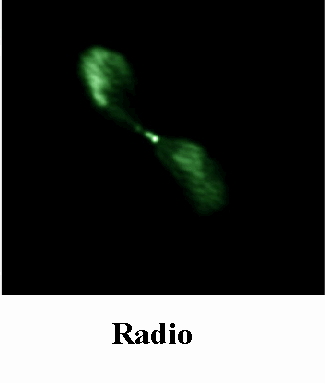 |
Here are the individual frames in the composite above (plus the
infrared one). The radio frame shows the jets emerging from the active nucleus,
particularly their outer parts expanding into intergalactic space. In hydrogen, we see a
huge disk of material surrounding the nucleus perpendicular to the jets. In the infrared,
we see the warm dust tracing the remains of the spiral galaxy that has recently been
swallowed by the large elliptical. The optical shows the stars, and some of the dust from
the spiral galaxy. In the X-rays, we see the inner parts of the jets from the active
nucleus.
|
Quasars were first distinguished in the early 60s because some very
bright radio sources were identified with starlike objects on photographs
 Visible
light picture of the QSO 3C279 (From NASA Extragalactic Database)
Visible
light picture of the QSO 3C279 (From NASA Extragalactic Database)

Of 3C273 (Also from NED)
Hubble's Law and the Nature of Quasars
Although they appeared to be stars, quasars were seen to be
very peculiar ones if that was what they really were:
- These "stars" had peculiar colors being much
brighter in the ultraviolet than normal stars and redder at longer wavelengths
- Spectra were even stranger with very strong and broad
emission lines but which occurred at wavelengths that did not seem to match up to known
elements. The shapes and strengths of the lines, but not their wavelengths, were
reminiscent of those from Seyfert galaxies.
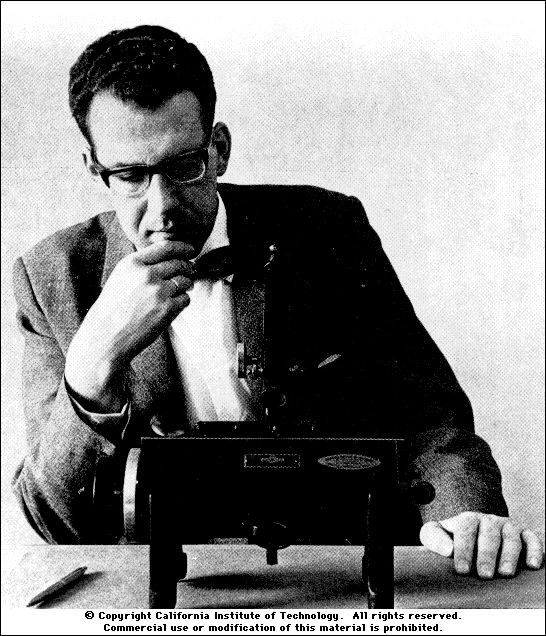 |
The spectra of QSOs didn't remain mysterious
for long. Maarten Schmidt figured out the
"mystery" of QSO spectra in 1963.(From California Institute
of Technology)
QSOs are NOT made of mysterious elements.
QSOs do have very LARGE redshifts -- some of them are
moving at nearly 90% the speed of light.
The spectra had appeared strange because spectral lines produced in the
ultraviolet had been shifted into the visible part of the spectrum. Astronomers were not
used to seeing ultraviolet lines, much less seeing them in the visible spectral range!. |
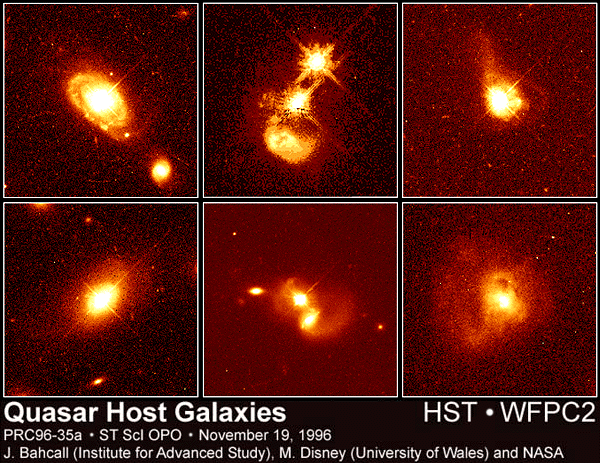 |
Needless to say, this idea was controversial for a while, in part
because it required them to have HUGE energy outputs. Some astronomers
proposed that the quasars were "local" but for some reason had been given large
velocities.
However, we can now take pictures, especially with
HST, that show they all lie in the centers of galaxies and are therefore indeed
similar to scaled-up versions of Seyfert and radio galaxies. |
It is now accepted that quasars are active galaxy nuclei
that are so bright we can see them to great distances, and hence their lines are
redshifted by huge amounts according to Hubble's Law. Under this interpretation, they are
the most luminous single objects in the Universe.
Their properties resemble those of radio galaxies. For example, to the left
(above) is an image showing the jet of 3C273 in the optical (From J.
Bahcall, STScI), and to the right a radio image (Taken
with MERLIN http://www.merlin.ac.uk/
), is superimposed on the optical one. 3C273 has a jet similar to, but much
bigger than, the one in M87.
Quasar spectra have very broad emission lines, like for Seyfert galaxies although
generally even broader.
Their light output has been seen to vary on timescales
as short as a day.
===> this implies that the region producing emission
from QSOs must be very small, as small as only a light day across (about 3 times the
distance of Pluto)
===> that 10,000 times the luminosity of the Milky
Way is coming from a region no bigger than the Solar System stretches the laws of physics.
Only the energy generated by falling into a black hole can satisfy these requirements.
Although originally discovered as radio sources, many more
"radio-quiet" QSOs have been found. These are very analogous to scaled-up
versions of Seyfert galaxies.
What is the physical cause of this extreme emission?
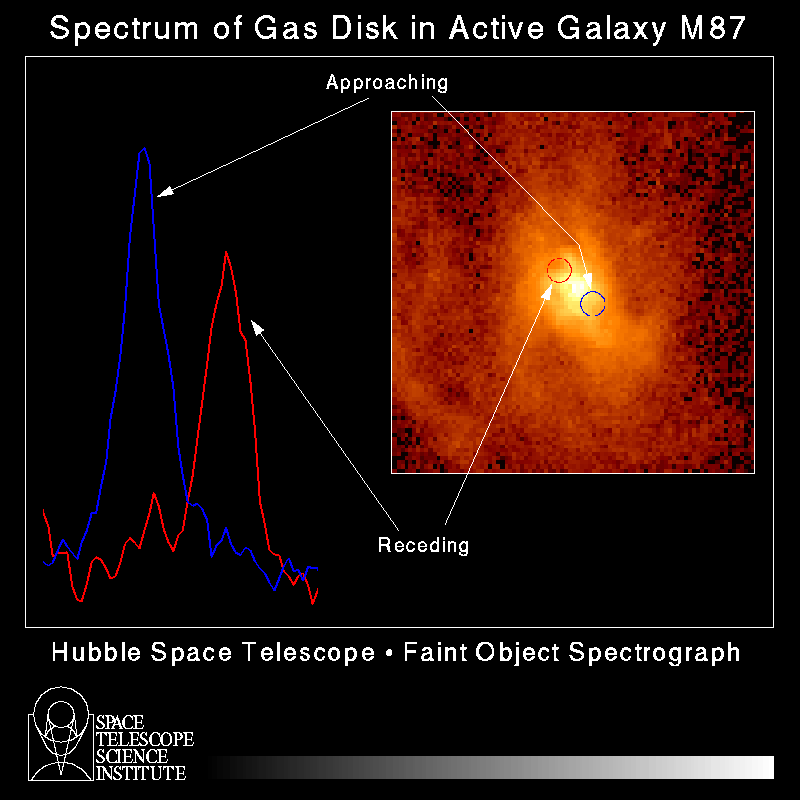 |
We are now convinced that all active nuclei derive their energy from
matter falling into very massive (up to a billion times the mass of the sun) black holes. In
some cases, we can see a disk of gas in rapid orbital motion
around the black hole, which is presumably the matter on the way to falling in and
releasing huge amounts of energy. (from
Hayden Planetarium, audiovisual archive)
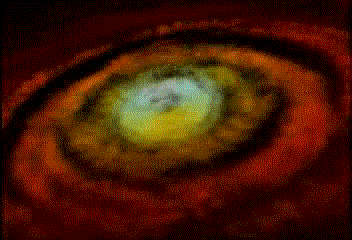
|
The radio emission is synchrotron
radiation which is produced by electrons moving rapidly (near the speed of light) in a
magnetic field. When we see the jets in the infrared and optical, the emission appears
also to be synchrotron radiation.
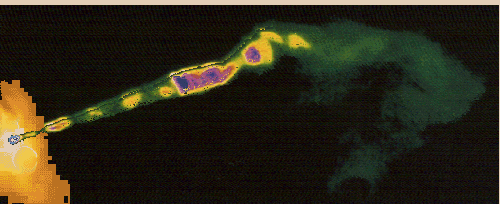 |
In this radio image of M87, the galaxy with the black hole and
surrounding disk above, there is a narrow "jet" of high energy material coming
out of the center. We have superimposed the optical image of the
galaxy nucleus to show how the jet is perpendicular to the disk. (From
F. Owen et al. http://www.aoc.nrao.edu/~fowen/M87.html) |
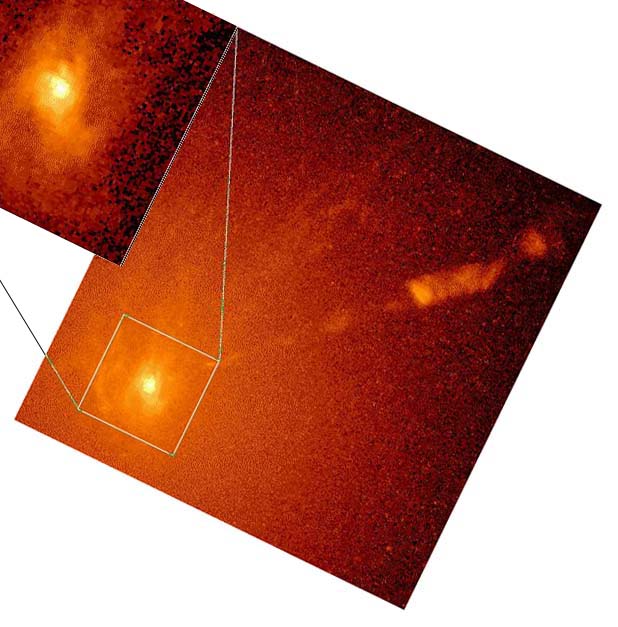 |
We have an even clearer view in the optical, as shown in this HST
image. (From STScI) |
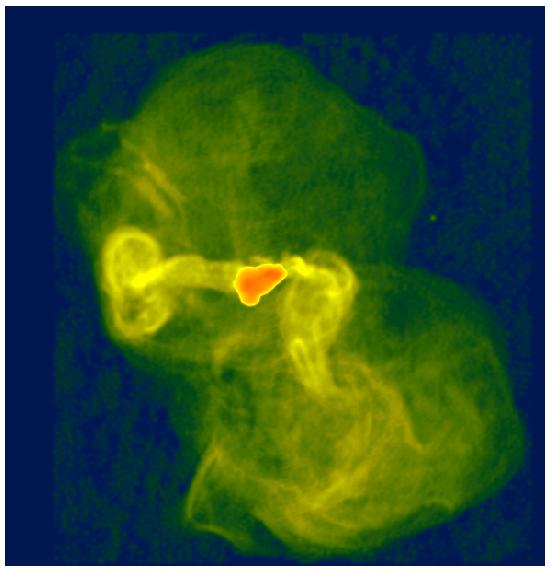 |
A large scale image of M87 shows how the particles from the jet leak
out into intergalactic space. The jet images above are within the burned out region in the
center. (From NRAO, D. Finley, http://www.nrao.edu/pr/1999/m87big/)
|
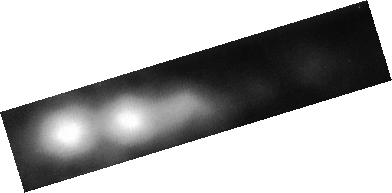 |
The bright knot in the "jet" shows shocks passing through.
This animation is based on 6 years of data with the Hubble Space Telescope (Animation
by G. Rieke, data from Biretta et al.) |
It is not clear how such long and narrow structures are maintained, but
it must involve large scale and strong magnetic fields. The
motions in the jets appear to exceed the speed of light -- M87 is typical, and the movement in the
animation above works out to 6 times the speed of light. We still believe in the theory of
relativity, that says nothing can really move faster than light, so we explain
what we see in these jets as a kind of optical illusion.
-- M87 is typical, and the movement in the
animation above works out to 6 times the speed of light. We still believe in the theory of
relativity, that says nothing can really move faster than light, so we explain
what we see in these jets as a kind of optical illusion.

|
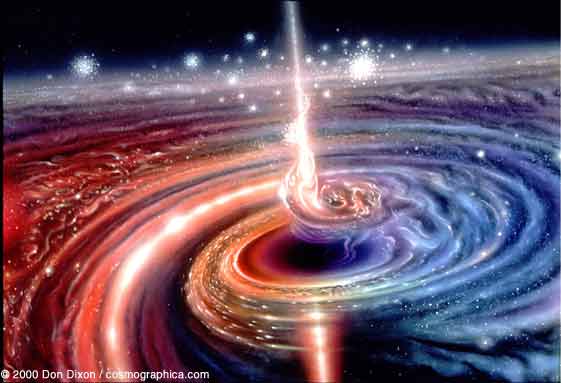 |
| To get a better view, we have to use our imaginations.
Here are two artist's concepts (two concepts, one artist, Don Dixon) of what an active
nucleus might look like up close. |
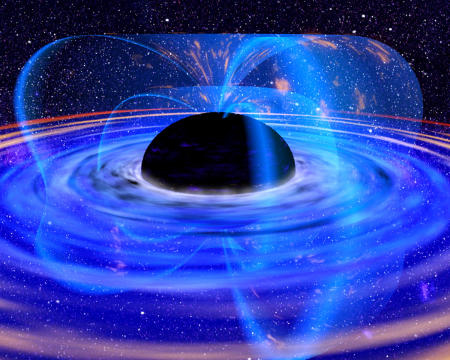 |
Here is how one artist imagines it might look close to the black
hole, with a hot accretion disk and loops of hot gas confined by strong magnetic fields. From
XMM Newton image gallery, http://sci.esa.int/home/xmm-newton/index.cfm. |
The extreme gravity of such massive blackholes may produce curious effects, if we
ever acquire the technology to get close to them 
Why do we study active galaxy nuclei
Test your understanding before going on








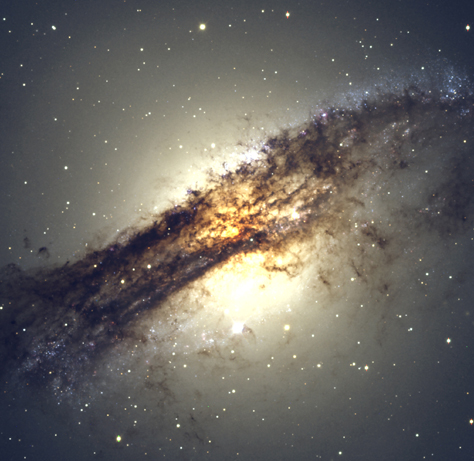
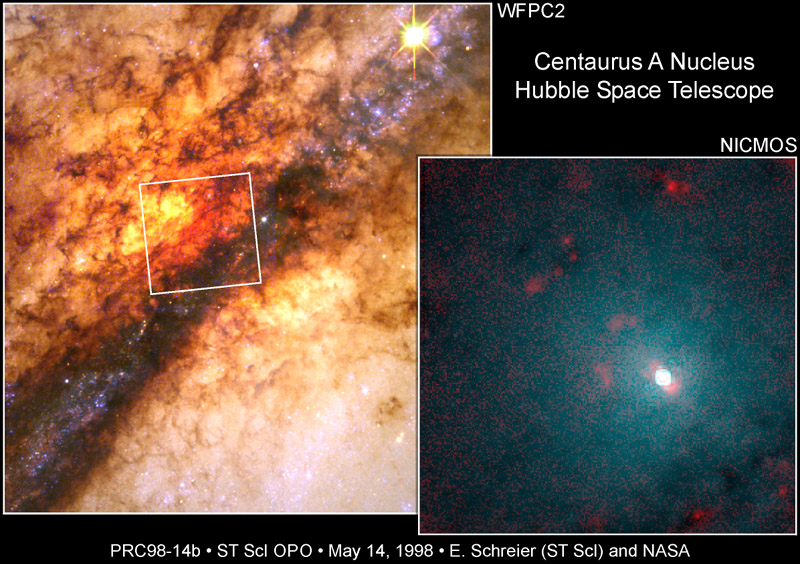
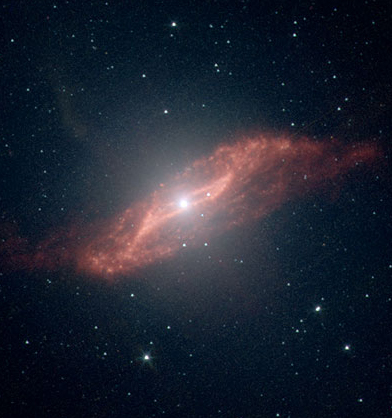
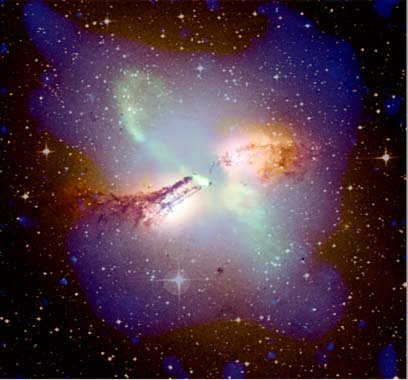

 Visible
light picture of the QSO 3C279 (From NASA Extragalactic Database)
Visible
light picture of the QSO 3C279 (From NASA Extragalactic Database)

